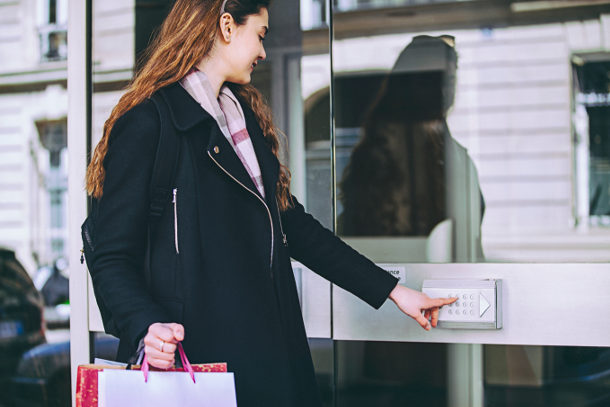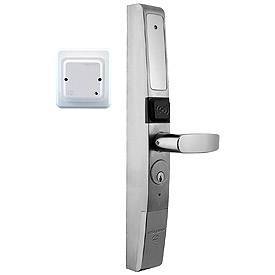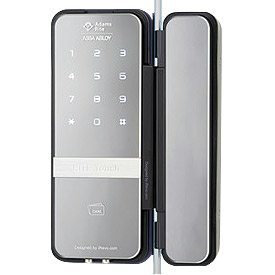
Often associated with vehicles, keyless door entry is also changing the way we access buildings and interact with public and private spaces. This convenient and time-saving technology isn’t new (relatively speaking), but you might be less familiar with the many features and options available today.
To help you make an informed decision for your building or facility, we’ll take a closer look at keyless entry locks and highlight the top five ways they make life better.
1. Convenience
Convenience is probably the first thing that comes to mind when thinking of keyless entry, but it’s about more than easy access or not having to fumble with keys any more. Keypads and other kinds of electronic door locks are often easy to install and maintain, even allowing retrofitting so you can quickly upgrade from a traditional mechanical door with minimal disruption.
In most cases these keyless entry locks are battery-powered, which eliminates the cost and hassle of routing wiring to the door, as well as preventing access issues from power failures. Battery-life indicators will ensure you’re never locked out, although some keyless entry doors also come with mechanical locks for added convenience.
Although keyless entry is designed to make life easier, its growing popularity has brought a huge range of options and things to consider.
PowerPlex self-powered electronic locks go a step further by harnessing energy from the user. Every turn of the lever generates the power needed to operate the lock, with built-in super capacitors capable of holding a full charge for up to 10 weeks.
Mechanical pushbutton locks offer another form of keyless entry without relying on batteries. Users gain access by entering a universal combination code. This cost-effective solution is easy to manage, though it lacks the versatility of other keyless door locks on the market today.
2. Better Access Control
For more security-sensitive applications or businesses with a high rate of employee turnover, it’s vital to have an access control system that can handle the specific needs of the building and its users. Keyless entry often plays a major role in this area. Mechanical keys can be lost, stolen or copied, but a password protects against this risk (provided it’s well-chosen and changed from time to time).
Some keyless door locks come with built-in access control features, including audit trails, multiple authority levels and the ability to program thousands of unique access codes or multiple schedules to restrict access times for certain users.

The A100 by Adams Rite offers all the benefits of keyless security, along with Aperio™ technology for real-time communication with an access control system
Others, such as the A100 keyless entry control lock by Adams Rite, offer integration with existing access control systems. The use of Aperio™ technology enables real-time wireless communication between the door lock and an online system, making it easy and cost-effective to expand an access control system.
3. Save Time and Money from Re-keying
As some companies know firsthand, the costs of re-keying mechanical locks can add up over time. This is especially true for businesses with high employee turnover, such as grocery stores and big-box retailers.
The turnover, long operating hours and large physical spaces present unique challenges for employers and security staff. Keeping track of physical keys requires extensive oversight and organization—both of which take time and money that could be better spent elsewhere.
With keyless entry locks, adding or revoking access is simple and instant. User-friendly features like multilingual voice guidance for programming and state-of the-art touchscreen technology make it easy to manage a high number of individuals without special tools or technical knowledge. This includes customizing levels and times of access.
4. Refined Styling
As keyless entry technology evolves, so does the visual styling. Many electronic door locks available today come in an attractive package made from durable materials that protect against not only unwanted access, but weather too.
The growing use of touchscreen interfaces in keyless door locks has contributed to the rise in design standards over traditional keypad locks. Their sleek and seamless surface provides a more elegant aesthetic that’s akin to modern devices like smartphones and tablets.

The surface-mounted RITE Touch digital glass door lock by Adams Rite combines elegant aesthetics with the latest touchscreen technology
If you’re considering a keyless door lock for your facility or home, just be sure it’s capable of handling the physical needs of your environment. Some locks are suited to indoor applications only, while others are designed to function under even the harshest weather conditions.
5. Advanced Security
Of course, locks are only as good as the level of security they provide. That holds true for high-tech electronic locks as much as it does for traditional mechanical models.
Keyless door locks are typically compatible with a variety of locking devices, including cylindrical latches, mortises, deadbolts, dead latches and exit devices. To ensure you’re getting the right functionality and level of security for your needs, it’s always best to talk to a specialist.
You can also compare product specs such as the ANSI/BHMA standards for auxiliary locks, which measure durability and security from Grade 1 (the highest) to Grade 3.
Many keyless entry locks also come with added security features, including:
- Anti-tamper lockout to restrict access after a certain number of failed attempts
- Adjustable code length
- Quick lockout option in case of a security concern
- The ability to delete user codes with a master code
- Multiple access modes, including PIN followed by card access
Although keyless entry is designed to make life easier, its growing popularity has brought a huge range of options and things to consider. If you’re thinking about upgrading to a keyless door lock, we can help you find the right product for your needs. Contact us today to find out just how easy it is to go keyless.


 blog
blog